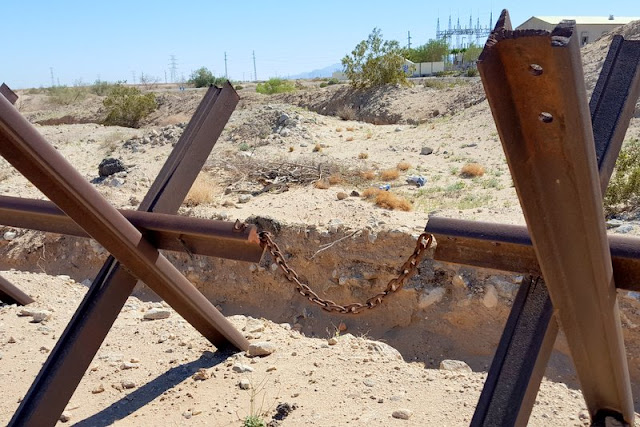 When we arrived at Rio Bend Resort, Denisa was reading the week's activities at the park. She was intrigued by the "Border Tour" scheduled for the next morning. After a couple phone calls, we were signed up to go to the local border patrol office the next day for their five-hour tour.
When we arrived at Rio Bend Resort, Denisa was reading the week's activities at the park. She was intrigued by the "Border Tour" scheduled for the next morning. After a couple phone calls, we were signed up to go to the local border patrol office the next day for their five-hour tour.It started with some classroom time with an explanation of their mission, and then a tour of their facilities. They have 11 processing rooms where they hold illegal immigrants for their return back to Mexico. A small percentage of these people will be from other countries, and their return is more difficult. Then we got information about the nonlethal and lethal tools they use in their job. Here Mark is getting some hands-on experience with the fire-arms on the lethal end of the table.
After an hour inside, we headed out into the desert with our officers. Here they could give us first-hand experience in the tracking they do in the sand every day. Their day would often start with dragging the sandy roads that would have to be crossed by people coming over the border. This tool is made from old tires, and is pulled behind their pickups to give a nice smooth surface that would show fresh foot prints.
Then they gave us tracking lessons, and tricks that illegals often use to try to fool them. One option is to break off a creosote branch to brush out their tracks. Another is walking backwards, or taking off their shoes. In the years they have worked at the border, they have seen it all.
Who knew that border patrol officers could be so entertaining? Our guides were lots of fun, telling us experiences from their jobs along the borders around the country.
With twenty people on-board, however, it was easy for all those people together to pick up one heavy sections. Then the pickup could drive through the opening in the barricade. So the sections had to be chained together to keep that from happening.
They've also added big cement pillars in front of this type of fence, because smugglers driving large numbers of people over the border can be very persistent.
Vehicles crossing the border illegally are also often carrying narcotics. The border patrol's mission includes stopping illegal drugs from entering the country. They are seeing that smugglers are using illegal immigrants to transport drugs. Individuals often pay a high price for the smuggler's help in getting across the border, as well as transportation within the United States. When the price goes up in the middle, the illegal immigrant's only option to pay the bill might be to agree to carry narcotics to deliver to their transportation source. Some times that might be a large back-pack of illegal drugs.
Our border patrol friends showed us that the fence comes in different forms. Here it changes from a vehicular fence, to a taller fence to make it harder for humans as well. They also pointed out that these are fences--different than the wall that we are hearing about in the news.
The border patrol drove us to the town of Calexico, California, which sits right on the border. This fence separates it from the one million people that live in Mexicali, Mexico. In fact, we could look through the fence to see the busy street that runs parallel with our city street on the U.S. side.
There are border patrol pickups and agents on bicycles tirelessly patrolling the U.S. side of that fence. Things happen faster within the city, and the crossings are more frequent than those in the desert. One of the problems is there is a line of houses right across the street, where illegals can find refuge in a hurry.
Again, the border patrol is trying to stop the illegal drugs that are crossing that fence as much as the illegal immigrants. They have seen an increase in the practice of throwing bags of drugs over that fence into the backyards of houses right on the border. With unlimited monetary resources, it is easy for the drug cartel to convince the residents of the low-income housing on the border to help them with this plan.
The drug cartel has been known to spend massive amounts of money to fund new schemes for their drug trafficking. Each year, the border patrol finds tunnels built to transport people and drugs across the border underground. One such discovery was found with a tunnel that ended inside this new house, built by cartel money a couple years ago.
Patroling the border is often a frustrating task. This brand new outlet mall was approved by the city of Calexico, with a back door just a few feet from the border fence. Now an illegal has a whole new series of places to hide as soon as they cross the border.
The other frustrating aspect to us is that when an illegal immigrant is caught, there doesn't seem to be a real penalty. They are finger-printed and processed, then transported back to Mexico. It's not unusual to catch the same person two days in a row, as there isn't a real penalty for getting caught. Because the border patrol can't be everywhere, there is always a good chance that the illegal alien will certainly be successful eventually.
Since we have lived along the Mexico border for several months, this was a great tour for us. We have seen many of the blimp-like surveillance balloons floating high above the ground. We found out these 55-foot balloons have military grade cameras capable of reading a license plate almost a mile away. Not long ago, we saw a blimp on the ground.
We learned a lot on our day with our favorite border patrolmen. We appreciate their mission and their jobs more, and we wish them safe and productive patrols!

























0 Response to "Riding With the Border Patrol"
Post a Comment